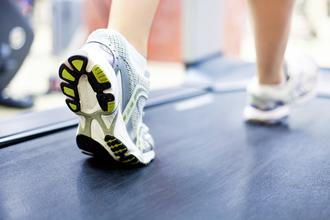Proactive Foot Care For Athletes

- posted: Mar. 02, 2022
Pounding pavement, intense box jumps, PR deadlifts…we couldn’t do the activities and exercise we love without healthy feet and ankles. Of course, feet and ankles are also prone to injury. The good news is that there are strategies and tips you can follow to proactively keep your feet and ankles healthy to reduce your risk for sports-related injuries.
Choose the Right Shoes for the Job
There’s a reason there are shoes just for runners, shoes for weightlifters, and shoes for soccer players. Every sport requires its own shoes that provide just the right cushioning, stability, and support for the feet and ankles. Wearing the right shoes for your chosen sport is imperative to providing your feet with exactly what they need whether it’s ankle stability for those quick side-to-side movements or added cushioning for power jumps.
Rotate Socks and Shoes Regularly
As you work out it’s natural for your feet to sweat; however, the last thing you want to do is leave your feet in sweaty shoes and socks. That’s why it’s always best to carry at least another pair of socks with you and to swap them out after exercise to prevent blisters or a nasty fungal infection. Always choose moisture-wicking socks to help wick away some of the sweat.
Know When to Get Rid of Your Shoes
No shoes are designed to last forever. While you may simply love your sneakers you have to recognize when to part ways and get a new pair. After all, shoes wear down over time and they are less likely to cushion or absorb shock, which can leave you prone to injuries. Shoes are only designed to last about 300-500 miles. If you see that the treads are wearing out this is a clear sign that it’s time to invest in a new pair of sneakers.
Train and Condition Regularly
It’s important that you condition your body and train even off-season so that your body is primed and ready once the season begins. Conditioning the body including the feet and ankles gets them prepared for activity, and it also means that you can increase intensity and duration gradually to reduce your risk for injury. Make sure that you are training throughout the season, even off-season.
Even if you aren’t dealing with foot or ankle problems, if you are physically active or an athlete, having a podiatrist that you turn to regularly for care and advice can go a long way to preventing injuries and other problems.

- posted: Mar. 02, 2022
Pounding pavement, intense box jumps, PR deadlifts…we couldn’t do the activities and exercise we love without healthy feet and ankles. Of course, feet and ankles are also prone to injury. The good news is that there are strategies and tips you can follow to proactively keep your feet and ankles healthy to reduce your risk for sports-related injuries.
Choose the Right Shoes for the Job
There’s a reason there are shoes just for runners, shoes for weightlifters, and shoes for soccer players. Every sport requires its own shoes that provide just the right cushioning, stability, and support for the feet and ankles. Wearing the right shoes for your chosen sport is imperative to providing your feet with exactly what they need whether it’s ankle stability for those quick side-to-side movements or added cushioning for power jumps.
Rotate Socks and Shoes Regularly
As you work out it’s natural for your feet to sweat; however, the last thing you want to do is leave your feet in sweaty shoes and socks. That’s why it’s always best to carry at least another pair of socks with you and to swap them out after exercise to prevent blisters or a nasty fungal infection. Always choose moisture-wicking socks to help wick away some of the sweat.
Know When to Get Rid of Your Shoes
No shoes are designed to last forever. While you may simply love your sneakers you have to recognize when to part ways and get a new pair. After all, shoes wear down over time and they are less likely to cushion or absorb shock, which can leave you prone to injuries. Shoes are only designed to last about 300-500 miles. If you see that the treads are wearing out this is a clear sign that it’s time to invest in a new pair of sneakers.
Train and Condition Regularly
It’s important that you condition your body and train even off-season so that your body is primed and ready once the season begins. Conditioning the body including the feet and ankles gets them prepared for activity, and it also means that you can increase intensity and duration gradually to reduce your risk for injury. Make sure that you are training throughout the season, even off-season.
Even if you aren’t dealing with foot or ankle problems, if you are physically active or an athlete, having a podiatrist that you turn to regularly for care and advice can go a long way to preventing injuries and other problems.
